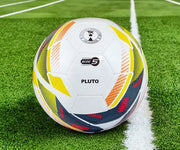Whether you're packing your gear for travel or adjusting air pressure for better performance, knowing how to deflate a soccer ball correctly is essential. While it might seem simple, improper deflation can damage your ball or valve. This guide walks you through how to deflate a soccer ball, the tools you'll need, and key tips to keep your ball in top shape.
Why Deflate a Soccer Ball?
Before we dive into the “how,” it helps to understand the “why.” Deflating your soccer ball can be useful in several situations:
-
Storage and Travel
A flattened ball takes up less space and is easier to transport.
-
Adjusting Air Pressure
Too much air can affect gameplay. Sometimes, you need to reduce air pressure for optimal control.
-
Preventing Over-Inflation
Leaving a ball fully inflated in extreme temperatures can damage the bladder or seams.
What You’ll Need
To safely deflate a soccer ball, gather the following:
-
Ball Pump with a Needle
Most soccer pumps come with a detachable inflation needle. This needle is crucial for both inflating and deflating.
-
Lubricant (Optional)
A drop of water or petroleum jelly can help insert the needle without damaging the valve.
-
Air Pressure Gauge
Helps monitor pressure if you're deflating to a specific level.
How to Deflate a Soccer Ball: Step-by-Step
Here’s the correct way to deflate a soccer ball without damaging it:
1. Find the Valve
Locate the small rubber valve on your soccer ball. It’s usually marked and sits between panels. The valve is the only entry point for air in or out.
2. Lubricate the Needle (Optional but Recommended)
Apply a small amount of water or lubricant to the needle to make insertion smoother and reduce friction on the valve. Avoid forcing a dry needle, as it can cause permanent damage.
3. Insert the Needle Gently
Slowly insert the inflation needle into the valve. Push it straight in—not at an angle—to avoid tearing the valve’s internal seal.
Important: Never use a pen, stick, or any sharp object. Only use a proper inflation needle.
4. Let the Air Escape
Once inserted, you’ll hear a soft hissing sound as the air begins to escape. You can either:
-
Let it deflate naturally, or
-
Squeeze the ball gently to speed up the process
For partial deflation (to adjust air pressure), keep an eye on the ball’s firmness or use an air pressure gauge.
How Much Air Should a Soccer Ball Have?
The ideal air pressure for a football (soccer ball) is generally between 8.5 to 15.6 psi (pounds per square inch), according to FIFA standards. However, the right pressure may vary based on:
-
Ball size (Size 3, 4, or 5)
-
Age group using the ball
-
Playing surface (firm ground, turf, indoor)
Check the printed recommendation on your specific ball for the best results.
Tips for Safe Deflation
To prevent damage and extend the life of your ball, follow these tips:
-
Avoid frequent deflation/inflation
Doing this too often can weaken the valve and bladder over time.
-
Store in moderate temperatures
Flattened balls stored in hot or cold climates can warp or crack.
-
Use only approved needles and pumps
Never improvise with household objects.
When Should You Deflate Your Soccer Ball?
Consider deflating your ball if:
-
You're travelling and need to pack it compactly.
-
You're storing it for a long time and want to prevent pressure buildup.
-
Your ball feels too firm, and you need better touch or control during play.
-
You're playing in hot weather, where internal pressure can expand naturally.
What Happens if You Don’t Deflate Properly?
Improper deflation can lead to:
-
Flattened balls with damaged bladders
-
Stretched or torn valves that leak air over time
-
Misshapen panels from uneven air escape or aggressive squeezing
By learning how to deflate a soccer ball the right way, you avoid these issues and increase the lifespan of your gear.
What About Automatic Ball Deflators?
Some advanced pump systems come with deflation settings or automatic air pressure regulation. These are commonly used in professional training settings and ensure the ball stays within the ideal air pressure for football standards. However, for most casual players and amateur teams, a manual needle works just fine.
Can You Over-Deflate a Soccer Ball?
Yes. A soccer ball that’s underinflated may not bounce properly, feel sluggish on the pitch, or even get damaged during play. That’s why it’s best to deflate only when needed and always reinflate to the recommended PSI before playing.
Frequently Asked Questions
Can I fly with an inflated soccer ball?
It’s recommended to deflate your ball slightly before air travel. Cabin pressure changes can cause the ball to over-expand.
How can I tell if my ball is properly inflated after deflating?
Use an air pressure gauge or the "bounce test." Drop the ball from waist height—it should bounce back up to around 50–65% of that height.
Will frequent deflation wear out my ball faster?
Yes, over time it can. The valve and bladder are not designed for constant adjustment. Try to limit how often you inflate and deflate unless necessary.
Conclusion
Knowing how to deflate a soccer ball the right way is a simple but important skill for any player, coach, or parent. Whether you're adjusting air pressure for a better touch, storing the ball for a long trip, or protecting it from heat, safe deflation ensures your ball stays in game-ready condition.
Always use the right tools, monitor air levels, and handle your ball with care. With proper technique, you'll avoid flattened balls and unnecessary wear—and keep scoring goals season after season.







